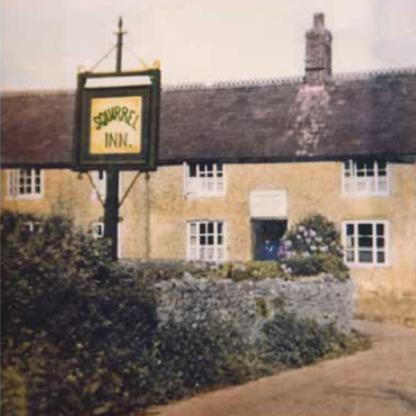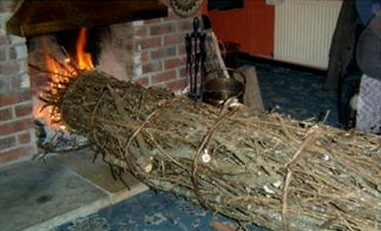There has been a pub on the site of The Squirrel at Laymore since the 17th century
and it is possible that as well as being a drinking hole, it was a cut-price marriage
shop.The original pub burnt down in the early 1950s.
original pub burnt down in the early 1950s.
The Squirrel. before the 1950s fire Reproduced by kind permission.©
Held in a variety of venues, these marriages either took the form of ‘handfasting
or trothplights’, also known as ‘the country manner’ or were solemnised according
to the order of service laid down by the Common Prayer Book. Officiates were not
always ordained although some were defrocked priests. In the south-west there was
also a tradition of ‘broomstick weddings’ where the couple jumped over a besom in
front of witnesses. The 1695 Marriage Duty Act introduced a tax on church marriages
which increased demand, for non-church ceremonies Cut price marriage shops undercut
the cost and were a popular alternative to church weddings. Couples who took their
vows in front of witnesses and consummated their union were legally married in the
eyes of the Church until the law changed in 1753 when irregular marriage was outlawed
by the Hardwick Marriage Act.
Among the 89 parishioners who signed the 1723 Devon Loyalty Oath, 17 are among
Thorncombe’s missing marryers, fathers of children baptised in Thorncombe during
1674-1723 but not listed in the marriage register. Altogether 708 children were fathered
by 295 missing marryers during for this period. While some may have been returning
emigrants or immigrants who married in church ceremonies elsewhere, others may have
undergone civil marriages under Oliver Cromwell’s administration, been married in
non-conformist establishments or participated in clandestine marriage ceremonies
in cut-price marriage shops.

Twelfth night faggot © The Squirrel. Reproduced by kind permission.
Either way these events are not easily traceable. In the absence of evidence to
the contrary, some of Thorncombe’s missing marryers might be among those who patronised
these covert establishments. While there is no documentary evidence, a local tradition
stopped during World War II, and revived in 1973, suggests a corrupt survival of
what once might have been a broomstick wedding ceremony. On twelfth night, women
hoping to become pregnant still jump over a burning faggot at the Squirrel Inn,
Laymore on the Somerset border of Thorncombe’s parish boundary.
Royal Oak
The wall of the Royal Oak next to the gate leading into Thorncombe parish churchyard
may also mark another place where clandestine marriages took place. In an article
in the TVT News dated winter 1999, Peter Bicknell drew attention to graffiti etched
into the wall of next to the gateway. He suggested that the carvings could be connected
to ‘hand fasting’ and this was the parish trysting spot. He identified the graffiti
as being mostly of 18th century origin and pointed out that it was ‘not of the
kind one associates with those more normally found outside pubs [being] … exclusively
devoted to declarations of love – expressed in its chasest form.’ Spring, appropriately
enough, is the best time to see the carvings when the early morning sun throws them
into sharp relief.. They depict, ‘the outline of a hand – generally the left, and,
being small probably that of the girl – and the more familiar depiction of a single
heart or of hearts within hearts. Quite a few are dated, and most bear initials rather
than full names.’ If as Peter Bicknell speculated, the churchyard carvings were
made to mark a hand fasting, perhaps they were carved by some of Thorncombe’s missing
maryrers?
For a list of Thorncombe’s ‘missing marryers’ cover the period 1674-1723 go to:
www.foda.org.uk/main/projects/eighteenthcentury/thorncombe
EVE HIGGS
July 2012




 original pub burnt down in the early 1950s.
original pub burnt down in the early 1950s. 